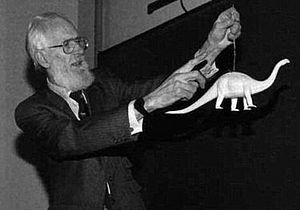Robert McNeill Alexander facts for kids
Quick facts for kids
R. McNeill Alexander
|
|
|---|---|
 |
|
| Born | 7 July 1934 |
| Died | 21 March 2016 |
Robert McNeill (Neill) Alexander (1934–2016) was a famous British zoologist. He was a top expert in biomechanics, which is the study of how living things move. For 30 years, he was a professor at the University of Leeds. He was especially known for figuring out how fast dinosaurs could run!
Contents
Early Life and School Days
Neill Alexander was born on July 7, 1934, in Lisburn, Northern Ireland. He was one of four sons. His dad was a chief engineer in Belfast. His mom, Janet McNeill, was a writer. She wrote over 20 children's books and even two opera stories!
Neill went to Tonbridge School and then to Trinity Hall, Cambridge University. There, he earned his first degrees and later a PhD. His PhD research was guided by Professor Sir James Gray. He also earned another special science degree from the University of Wales.
A Career in Animal Movement
Alexander started his teaching career in 1958 at the University College of North Wales. He became a professor at the University of Leeds in 1969. He stayed there until he retired in 1999.
Studying Fish and Land Animals
Early in his career, before 1970, Alexander mostly studied fish. He looked at how their swim bladders worked. He also studied how their tails and jaws helped them move.
Later, he became very interested in how animals move on land. He studied how mammals walk and run. He looked at how they choose different ways to move, called gaits. He also studied how their bones and muscles are designed for movement.
How Fast Did Dinosaurs Run?
One of Alexander's most exciting studies was about how dinosaurs moved. He created a special formula to guess their speed! People called it the 'dinosaur speed calculator'.
He used a math idea called the Froude number. This number helps compare how different-sized animals move. He watched modern animals to create his formula.
His formula looked like this: 
- v is the speed of the animal.
- g is the force of gravity.
- SL is the length of the animal's stride (how far it steps).
- h is the animal's hip height.
He realized this formula could work for dinosaur footprints! You can measure the stride length from the tracks. You can also guess the hip height from the size of the footprint.
At first, he thought dinosaurs moved slowly, about 1 to 3.6 meters per second. That's like 2 to 8 miles per hour. Later, he updated his ideas. He suggested that a Tyrannosaurus probably couldn't run faster than 8 meters per second. That's about 18 miles per hour.
Most calculations using his formula suggest dinosaurs usually moved around 3 meters per second (6 mph). Their top speed might have been around 8 meters per second (18 mph).
Leading Science Groups
Beyond his research, Alexander also helped lead important science groups. He was the secretary of the Zoological Society of London from 1992 to 1999. This meant he helped manage the London and Whipsnade Zoos. He also led the Society for Experimental Biology and the International Society of Vertebrate Morphologists. He was also an editor for a science journal called Proceedings of the Royal Society B.
Movies and TV Shows
Neill Alexander's knowledge was so important that he helped with many films and TV shows! He was a scientific advisor for some of them.
- Horizon (1976) – A TV documentary series.
- The Hot-Blooded Dinosaurs (1976)
- The Dinosaurs! (1992)
- Walking with Beasts (2001) – A TV series documentary where he was the main science advisor.
- The Future Is Wild (2003) – A TV series documentary.
- Extinct: A Horizon Guide to Dinosaurs (2001) – A TV documentary.
Awards and Recognitions
Alexander received many awards for his amazing work:
- 1979: Linnean Medal for Zoology from the Linnean Society of London.
- 1987: He became a Fellow of the Royal Society (FRS). This is a very high honor for scientists.
- 2000: He was made a Commander of the Most Excellent Order of the British Empire (CBE).
- 2001: He became an Honorary Member of the American Academy of Arts and Sciences.
- 2002: He was made an Honorary Fellow of the Zoological Society of London.
- 2003: He received the Borelli Award from the American Society of Biomechanics.
Personal Life
Neill Alexander married Ann Elizabeth Coulton in 1961. They had a son and a daughter.
Death
Robert McNeill Alexander passed away on March 21, 2016, at the age of 81. He is remembered for his important work in understanding how animals move, especially dinosaurs!
Selected Publications
Neill Alexander wrote many books and research papers. Here are some of them:
Books
- Functional Design in Fishes, 1967
- Animal Mechanics, 1968
- Size and Shape, 1971
- The Chordates, 1975
- Mechanics and energetics of animal locomotion, with G. Goldspink, 1977
- The Invertebrates, 1979
- Optima for Animals, 1982
- Locomotion of animals, 1985
- The Collins Encyclopedia of Animal Biology, 1986
- Elastic Mechanisms in Animal Movement, 1988
- Dynamics of Dinosaurs and other Extinct Giants, 1989
- Animals, 1990
- How dinosaurs ran, 1991
- The Human Machine, 1992
- Exploring Biomechanics: Animals in Motion, 1992
- Bones: The Unity of Form and Function, 1994
- Energy for Animal Life, 1999
- Principles of Animal Locomotion, 2003
- Human Bones: A Scientific and Pictorial Investigation, with Aaron Diskin, 2004
Papers
(This is a small sample from over 250 papers)
- The Densities of Cyprinidae, 1959
- Estimates of speeds of dinosaurs, 1976
- Tyrannosaurus on the run, 1996
- Dinosaur biomechanics, 2006
- Biomechanics: Stable Running, 2007
- Orangutans use compliant branches to lower the energetic cost of locomotion, 2007
- Biomechanics: Leaping lizards and dinosaurs, 2012

